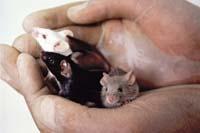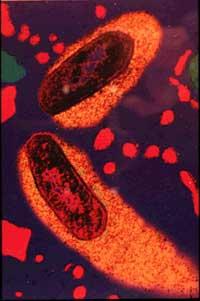More favor of intestinal bacteria in light
2011/05/01 Elhuyar Zientzia Iturria: Elhuyar aldizkaria

Several research has found that intestinal bacteria protect guests from various diseases
They prevent the flu, protect mice from the bacteria that produce inflammation and diarrhea until their death, and prevent the development of kwashiorkor disease that causes dystrophy and severe malnutrition to children with inadequate and inadequate nutrition. Three independent investigations have reached these three conclusions on the impact of intestinal bacteria in hoteliers.
Yale University studied the influence of intestinal bacteria on the risk of influenza. The study was carried out with two types of mouse, one with own bacterial community and another with antibiotics to eliminate intestinal bacteria. Well, they observed that mice treated with antibiotics had a higher propensity to the flu.
Researchers have explained that intestinal bacteria activate some protein complexes of the immune system, inflamasomas. And as a result of a chain of reactions that launch inflamasomas, dendritic cells begin to attack the flu virus. In mice that had destroyed intestinal bacteria there was no activation of inflammatory agents or the subsequent chain of reaction.
Another study with mice at British Columbia University examined whether intestinal bacteria protected Citrobacter rodentium infection. In fact, the researchers knew that this infection causes the death of some mice and others did not. To test whether the difference between both mouse types was in intestinal bacteria, disease-sensitive mice were first destroyed by all intestinal bacteria. They subsequently fed the feces of resistant mice and were resistant to disease for about a month. It has been explained that the bacteria of resistant mice cause the increase of the IL-22 messenger of the immune system. However, in the inhibition of this messenger, the mouse had a greater tendency to die for diarrhea.

Finally, a study from the University of Washington reveals that the development or not of kwashiorkor disease involves the development of one or another community of intestinal bacteria in children with poor and inadequate nutrition. In this case, 317 pairs of twins from Malawi were followed up to three years after their birth. Only 7% of the cases detected that the two twins had developed the disease, while in 50% of the cases only one of the two twins had the disease kwashiorkor.
As they believed that intestinal bacteria were responsible for this difference, the bacterial communities were eliminated and replaced by the communities of some of these twins. They were given the food that children eat (90% corn flour and 10% vegetables) and saw that mice that had intestinal bacteria from children with kwashioroso had lost more weight than others. On the contrary, in developing countries, by feeding on the usual preparation for malnourished children, they obtained a negative result.
Researchers at the University of Washington have stated that this does not "prove" that intestinal bacteria are solely responsible for kwashiorkor disease, but have some influence.

Gai honi buruzko eduki gehiago
Elhuyarrek garatutako teknologia






